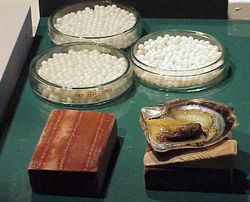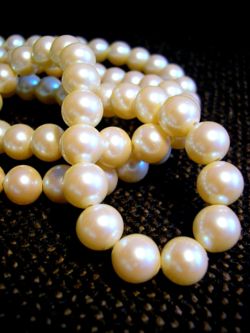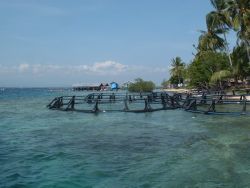Pearl
2007 Schools Wikipedia Selection. Related subjects: Everyday life
A pearl is a hard, rounded object produced by certain animals, primarily mollusks such as oysters. Pearls can be used in jewelry and also crushed in cosmetics or paint. Pearl is valued as a gemstone and is cultivated or harvested for jewelry.
Pearls are formed inside the shell of certain bivalve mollusks. As a response to an irritant inside its shell, the mollusk will deposit layers of calcium carbonate (CaCO3) in the form of the minerals aragonite or calcite (both crystalline forms of calcium carbonate) held together by an organic horn-like compound called conchiolin. This combination of calcium carbonate and conchiolin is called nacre, or as most know it, mother-of-pearl. The commonly held belief that a grain of sand acts as the irritant is in fact rarely the case. Typical stimuli include organic material, parasites, or even damage that displaces mantle tissue to another part of the animal's body. These small particles or organisms enter the animal when the shell valves are open for feeding or respiration. In cultured pearls, the irritant is typically a cut piece of the mantle epithelium, together with processed shell beads, the combination of which the animal accepts into its body.
The unique lustre of pearls depends upon the reflection and refraction of light from the translucent layers and is finer in proportion as the layers become thinner and more numerous. The iridescence that some pearls display is caused by the overlapping of successive layers, which breaks up light falling on the surface. Pearls are usually white, sometimes with a creamy or pinkish tinge, but may be tinted with yellow, green, blue, brown, purple, or black. Black pearls, frequently referred to as Black Tahitian Pearls, are highly valued because of their rarity; the culturing process for them dictates a smaller volume output and can never be mass produced. This is due to bad health and/or non-survival of the process, rejection of the nucleus (the small object such as a tiny fish, grain of sand or crab that slips naturally inside an oyster's shell or inserted by a human), and their sensitivity to changing climatic and ocean conditions.
The largest pearl ever found, so far, came from the Philippines in 1934. It weighed 14 lbs (6.36 kgs) when it was discovered by an anonymous Muslim Filipino diver off the island of Palawan. Later, a Palawan chieftain gave the pearl to Wilbur Dowell Cobb in 1936 as gift for having saved the life of his son. It was first called the Pearl of Allah and is now officially named the Pearl of Lao-tze.
Pearls fit into two categories: freshwater and saltwater. As their name implies, freshwater pearls are formed in freshwater mussels that live in lakes, rivers, ponds and other bodies of fresh water. Most freshwater cultured pearls sold today come from China. By contrast, saltwater pearls grow in oysters that live in the ocean, usually in protected lagoons. Akoya, South Sea and Tahitian are the three main types of saltwater pearls.
History
Before the beginning of the 20th Century, pearl hunting was the most common way of harvesting pearls. Divers manually pulled oysters from ocean floors and river bottoms and checked them individually for pearls. Not all natural oysters produce pearls, however. In fact, in a haul of three tonnes, only three or four oysters will produce perfect pearls.
Now, however, almost all pearls used for jewelry are cultured by planting a core or nucleus into pearl oysters. The pearls are usually harvested three years after the planting, but it can take up to as long as six years before a pearl is produced. This mariculture process was first developed by Kokichi Mikimoto in Japan, who was granted a patent for the process in 1896. The nucleus is generally a polished bead made from mussel shell. Along with a small scrap of mantle tissue from another oyster to serve as an irritant, it is surgically implanted near the oyster's genitals. Oysters which survive the subsequent surgery to remove the finished pearl are often implanted with a new, larger nucleus as part of the same procedure and then returned to the water for another three years of growth.
The original Japanese cultured pearls, known as Akoya pearls, are produced by a species of small oysters no bigger than 6 to 7 cm in size, hence Japanese pearls larger than 10 mm in diameter are extremely rare and highly prized. In the past couple of decades, cultured pearls have been produced with larger oysters in the south Pacific and Indian Ocean. One of the largest pearl-bearing oysters is the Pinctada maxima, which is roughly the size of a dinner plate. South Sea pearls are characterized by their large size and silvery colour. Sizes up to 14 mm in diameter are not uncommon. Australia is one of the most important sources of South Sea pearls. Tahitian pearls (also referred to as Titian pearls) are also another South Sea pearl.
In 1914 pearl farmers began culturing freshwater pearls using the pearl mussels native to Lake Biwa. This lake, the largest and most ancient in Japan, lies near the city of Kyoto. The extensive and successful use of the Biwa Pearl Mussel is reflected in the name Biwa pearls, a phrase nearly synonymous with freshwater pearls in general. Since the time of peak production in 1971, when Biwa pearl farmers produced six tons of cultured pearls, pollution and overharvesting have caused the virtual extinction of this animal. Japanese pearl farmers now culture a hybrid pearl mussel—a cross between the last remaining Biwa Pearl Mussels and a closely related species from China—in other Japanese lakes.

In the 1990s, Japanese pearl producers also invested in producing cultured pearls with freshwater mussels in the region of Shanghai, China, and in Fiji. Freshwater pearls are characterized by the reflection of rainbow colors in the luster. Cultured pearls are also produced using abalone.
Jewelry
The value of the pearls in jewelry is determined by a combination of the luster, colour, size, lack of surface flaw and symmetry that are appropriate for the type of pearl under consideration. Among those attributes, luster is the most important differentiator of pearl quality according to jewelers. All factors being equal, however, the larger the pearl the more valuable it is. Large, perfectly round pearls are rare and highly valued. Teardrop-shaped pearls are often used in pendants. Irregular shaped pearls are often used in necklaces.
Pearls come in eight basic shapes: round, semi-round, button, drop, pear, oval, baroque, and ringed. Perfectly round pearls are the rarest and most expensive, and are generally used in necklaces, or strings of pearls. Semi-rounds are also used in necklaces or in pieces where the shape of the pearl can be disguised to look like it is a perfectly round pearl. Button pearls are like a slightly flattened round pearl and can also make a necklace, but are more often used in single pendants or earrings where the back half of the pearl is covered, making it look like a larger, round pearl.
Drop and pear shaped pearls are sometimes referred to as teardrop pearls and are most often seen in earrings, pendants, or as a centre pearl in a necklace. Baroque pearls have a different appeal to them than more standard shapes because they are often highly irregular and make unique and interesting shapes. They are also commonly seen in necklaces. Ringed pearls are characterized by concentric ridges, or rings, around the body of the pearl.
In general, cultivated pearls are less valuable than natural pearls, and imitation pearls are the least expensive. One way that jewellers can determine whether a pearl is cultivated or natural is by x-raying the pearl. If the grit in the centre of the pearl is a perfect sphere, then the jeweller knows it is cultivated. This is because when the cultivators insert the grit, (usually a polished piece of mussel shell), it is always perfectly round, so as to produce a more expensive, perfectly round pearl. If the centre is not perfectly round, the jeweller recognises that it is genuine, and gives it a higher value. Imitation pearls are much easier to identify by jewellers. Some imitation pearls are simply made of mother-of-pearl, coral or conch, while others are made from glass and are coated with a solution containing fish scales called essence d'Orient. Although imitation pearls look the part, they do not have the same weight or smoothness as real pearls, and their luster will also dim greatly.
There is also a unique way of naming pearl necklaces. While most other necklaces are simply referred to by their physical measurement, strings of pearls have their own set of names that characterize the pearls based on where they hang when worn around the neck. A collar will sit directly against the throat and not hang down the neck at all, they are often made up of multiple strands of pearls. Pearl chokers nestle just at the base of the neck. The size called a princess comes down to or just below the collarbone. A matinee of pearls falls just above the breasts. An opera will be long enough to reach the breastbone or sternum of the wearer, and longer still, a pearl rope is any length that falls down farther than an opera.
Necklaces can also be classified as uniform, where all the pearls are the same size, graduated, where the pearls are arranged in size from large in the centre to smaller at the ends, or tin cup, where pearls are generally the same size, but separated by lengths of chain.




